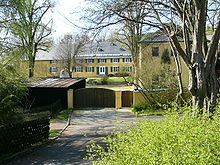Manor Bug
The Bug manor was a manor in Bug , today part of the community of Weißdorf . After previous buildings, the manor was followed by a castle at the end of the 18th century, which still exists as an extensive estate.
history
The development of fortified residences in the bow began with the Tower Hill conditioning tower hill Rear Buberg on the Bugberg and another plant in the village, because hardly visible traces in the terrain as Burgstall be designated Burg bug is. Both systems are difficult to date, according to the settlement history of the region they date from the 12th or a later century. Such tower mounds had a protective and representational character for the clearing lords, in the case of Bug it can be assumed that the medieval trunk road via Weißdorf and Schwarzenbach on the Saale and a ford on the Saale in the direction of Wulmersreuth were secured . A stone bower was mentioned several times in the village in 1502 .
At the beginning of the 14th century, the von Sparneck family appeared as owners in Bug. The manor consisted of a stately manor and a mill. In contrast to the current location of the estate, the mansion was on the opposite side of the street, where a playground was built in 1980; the last traces of the terrain disappeared. Only in the northeast has a section of a ditch survived. Norbert Goßler assumes that the manor was destroyed when the Hussites invaded in 1430 or during the Franconian War in 1523, as existing buildings later remained uninhabited and Bug was certainly not spared from the devastation in the area. Weytzndarff Castle is linked to a riddle (see Wandereisen woodcuts from 1523 ) - there are many reasons for the assumption that it should be equated with the manor in Bug, but there is no certainty about this. The manor was built at the end of the 16th century with stones from the old complex and the Uprode Castle and was soon connected to a sheep farm .
The Knights of Sparneck in the Weißdorfer line can be traced back to 1590 with extensive possessions in Bug. Since they repeatedly pledged the manor and their property to the burgraves of Nuremberg or the later margraves , other people were mortgaged with property in Bug at short notice. In 1590, the related von Tettau family inherited the property including the neighboring Uprode Castle and kept it until the middle of the 17th century. Other well-known families such as von Lindenfels and von Schönburg-Waldenburg followed.
In 1783, according to Helfrecht's report, Johann Georg August Friedrich von Lindenfels broke off the remains of the manor and built a palace in the immediate vicinity. The chemist Johann Wolfgang Döbereiner grew up there as the son of the estate manager. At the beginning of the 19th century the castle was again described as dilapidated. It was split in half and changed hands. The facility passed to the von Schönburg family in 1848 and fell victim to a fire in 1884. The sum of the fire insurance was not used for the reconstruction, but for the construction of the Fahrbühl hunting lodge . Nevertheless, the south wing and a later structurally modified gatehouse remained . In one of the outbuildings of the castle estate, an exposed groin vault over Gurten was only dated to the 16th century in 1961 . In 1881 a treasure was found that the castle owners had buried during the Thirty Years' War .
Otto Stritzel flourished during the Second World War. He combined the sheep farm with a weaving mill and manufactured high-quality textiles with up to 300 employees. In 1972 the company had to close for economic reasons.
Lothar Ulsamer, who bought the manor in 1998, is the 40th owner since it was founded. He settled there in order to set up the sheep farm on the Bugberg again.
literature
- Tilmann Breuer : District of Münchberg . The art monuments of Bavaria , brief inventories, XIII. Band . Deutscher Kunstverlag , Munich 1961, p. 10.
- Norbert Goßler: Rittergut Bug near Weissdorf . In: Miscellanea curiensia . Hof 2005, pp. 67–102.
- Johann Theodor Benjamin Helfrecht : Ruins, antiquities and still standing locksmiths on and on the Fichtelgebirge. One try. 1795. p. 129. ( online )
- Annett Haberlah-Pohl: Historical Atlas of Bavaria . Francs. Münchberg - The Altlandkreis (Series I, Volume 39). Munich 2011, ISBN 9783769665567 , p. 236 ff.
Web links
- Aerial view of the Bugberg and Bug with the BayernViewer
- Report by the "Frankenpost" on the checkered history of the Bug manor
Individual evidence
- ^ Friedrich von Schönburg-Waldenburg, Rudolf Timper: History of Schwarzenbach an der Saale . Schwarzenbach an der Saale 1908. S. 114f.
Coordinates: 50 ° 11 ′ 44.4 ″ N , 11 ° 50 ′ 50.1 ″ E



